
Atypidae, also known as atypical tarantulas or purseweb spiders, is a spider family containing only three genera. They are accomplished ambush predators that spend most of their time in a sock-like, silken retreat on the ground from where they kill their prey.

The spider species Araneus diadematus is commonly called the European garden spider, cross orbweaver, diadem spider, orangie, cross spider, and crowned orb weaver. It is sometimes called the pumpkin spider, although this name is also used for a different species, Araneus marmoreus. It is an orb-weaver spider found in Europe, where it is native, and North America, where it was introduced.

Nephila is a genus of araneomorph spiders noted for the impressive webs they weave. Nephila consists of numerous species found in warmer regions around the world, although some species formerly included in the genus have been moved to Trichonephila. They are commonly called golden silk orb-weavers, golden orb-weavers, giant wood spiders, or banana spiders.
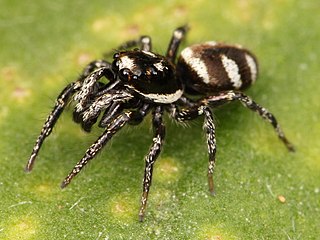
The zebra spider is a common jumping spider of the Northern Hemisphere. Their common name refers to their vivid black-and-white colouration, whilst their scientific name derives from Salticus from the Latin for “jump”, and the Greek scenicus, translating to “theatrical” or “of a decorative place,” in reference to the flashy, zebra-like coloration of the species.

Phidippus audax, the Bold jumper or Daring jumping spider, is a common species of spider belonging to the genus Phidippus, a group of jumping spiders easily identified by their large eyes and their iridescent chelicerae. Like all jumping spiders, they have excellent stereoscopic vision that aids them in stalking prey and facilitates visual communication with potential mates during courting. Bold jumping spiders are native to North America and have been introduced to Hawaii, Nicobar Islands, Azores, and the Netherlands. They are typically black with a distinct white triangle on their abdomen.

Atypus, also called purseweb spiders, is a genus of atypical tarantulas first described by Pierre André Latreille in 1804. It occurs in Eurasia, with one species reaching into North Africa. Only three of the described species occur in Europe: A. piceus, A. affinis, and A. muralis. Specimens from the USA formerly known as A. snetsingeri represent an introduced population of A. karschi.

Sphodros rufipes, sometimes called the red legged purseweb spider, is a mygalomorph spider from the southern United States, though it has been photographed as far north as Indiana, Missouri, New Jersey, Minnesota, Tennessee, Delaware, Louisiana, and Tuckernuck Island in Massachusetts [West Virginia]. A recent sighting shows that these spiders can also be found in Canada. Recent sighting also in Kansas.

Nephila pilipes is a species of golden orb-web spider. It resides all over countries in East and Southeast Asia as well as Oceania. It is commonly found in primary and secondary forests and gardens. Females are large and grow to a body size of 30–50 mm, with males growing to 5–6 mm. It is the second largest of the orb-weaving spiders apart from the recently discovered Nephila komaci. The first, second, and fourth pairs of legs of juvenile females have dense hairy brushes, but these brushes disappear as the spider matures.

Atypus karschi is a mygalomorph spider found in Korea, China, Taiwan, and Japan. It has been introduced into the United States. First described in 1887 by Friedrich Karl Wilhelm Dönitz, the specific name honors arachnologist Friedrich Karsch.
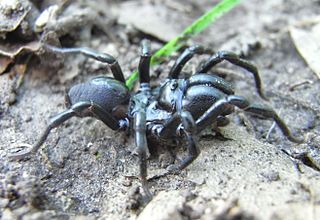
Atypus piceus is a mygalomorph spider of the family Atypidae. It occurs in Europe to Moldavia and in Iran, and is the type species of the genus Atypus.

Sphodros niger, the black purse-web spider, is a mygalomorph spider from the Eastern United States. It is listed as a special concern species in Connecticut.
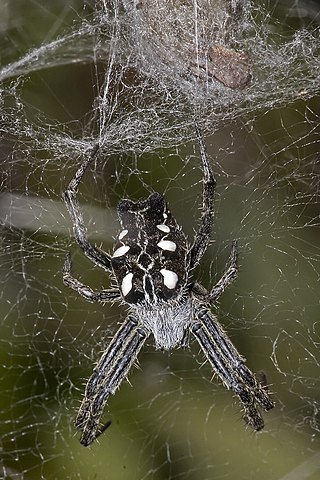
Cyrtophora citricola, also known as the tropical tent-web spider, is an orb-weaver spider in the family Araneidae. It is found in Asia, Africa, Australia, Costa Rica, Hispaniola, Colombia, and Southern Europe and in 2000, it was discovered in Florida. C. citricola differs from many of its close relatives due its ability to live in a wide variety of environments. In North America and South America, the spider has caused extensive damage to agricultural operations.

Spiders are air-breathing arthropods that have eight limbs, chelicerae with fangs generally able to inject venom, and spinnerets that extrude silk. They are the largest order of arachnids and rank seventh in total species diversity among all orders of organisms. Spiders are found worldwide on every continent except Antarctica, and have become established in nearly every land habitat. As of November 2023, 51,673 spider species in 136 families have been recorded by taxonomists. However, there has been debate among scientists about how families should be classified, with over 20 different classifications proposed since 1900.
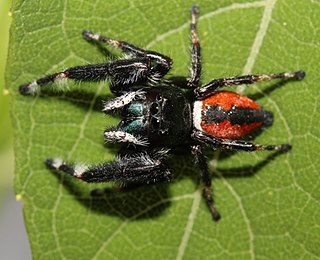
Phidippus clarus, also known as the brilliant jumping spider, is a species of jumping spider found in old fields throughout eastern North America. It often waits upside down near the top of a plant, which may be useful for detecting prey, and then quickly jumps down before the prey can escape. The spider is one of 60 species in the genus Phidippus, and one of about 5,000 in the Salticidae, a family that accounts for about 10% of all spider species. P. clarus is a predator, mostly consuming insects, other spiders, and other terrestrial arthropods.

Pardosa amentata, otherwise known as the wolf spider or spotted wolf spider is a species of spider in the genus Pardosa belonging to the family of wolf spiders, Lycosidae. The species has a widespread distribution in central Europe and northwestern Europe and are commonly found on the British Isles. The species hunts its prey on the ground rather than weaving a web.
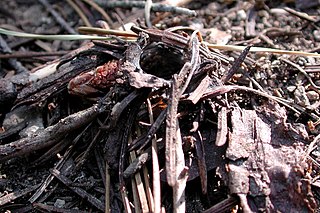
Atypoides riversi, known as turret spider, is a species of mygalomorph spider in the family Antrodiaetidae. It is a medium-sized spider native to Northern California that constructs a burrow with a turret made of soil, vegetation and silk. This spider's length is 13 to 18 millimetres long, though females are larger than males.
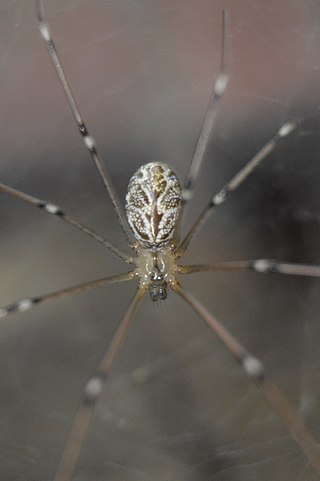
Holocnemus pluchei, commonly known as the marbled cellar spider, is a species of Pholcidae, a family commonly referred to as "cellar spiders" or "daddy long-legs". This species is distributed across the North Pacific region of the United States, as well as in parts of North Africa, Europe, and the Mediterranean. It is considered a common household spider and builds its nest in attics, basements, and eaves of houses. Although some members of the species live in solitary webs, the majority join already existing webs and migrate to new webs multiple times throughout the course of their lives. A unique feature of H. pluchei is that while in many species of spiders, stridulation commonly occurs by males during sexual encounters, in H. pluchei, females also possess stridulatory organs, and both sexes engage in stridulation.

Xysticus cristatus, the common crab spider, is a European spider from the family Thomisidae.

Stegodyphus dumicola, commonly known as the African social spider, is a species of spider of the family Eresidae, or the velvet spider family. It is native to Central and southern Africa. This spider is one of three Stegodyphus spiders that lives a social lifestyle. This spider has been studied living in large natal colonies in large, unkempt webs. Each colony is composed mainly of females, where a minority act as reproducers, and a majority remain childless and take care of the young. Males live a shorter lifespan, during which they will largely remain in the natal nest. Females are known for extreme allomaternal care, since all females – even unmated virgin ones – will take care of the young until they are eventually consumed by the brood.
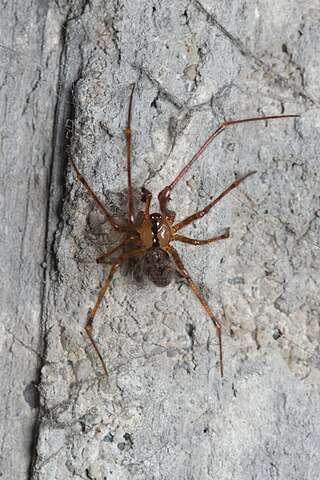
Nesticus cellulanus, also known as the cavity spider or comb-footed cellar spider, is a species of scaffold web spider. It is found throughout Europe and Turkey, and has been introduced to North America.




















